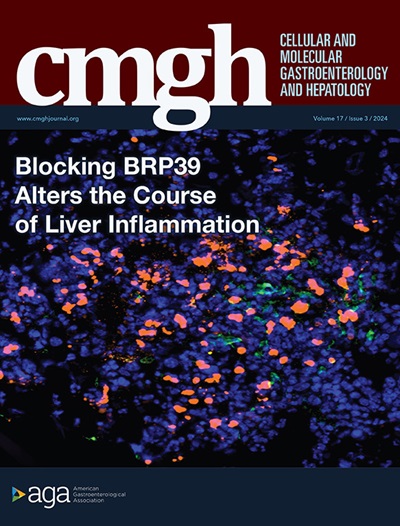DDIT4对幽门螺杆菌诱导胃化生的保护作用及其对铁下垂的代谢调节。
IF 7.1
1区 医学
Q1 GASTROENTEROLOGY & HEPATOLOGY
Cellular and Molecular Gastroenterology and Hepatology
Pub Date : 2025-01-01
DOI:10.1016/j.jcmgh.2024.101448
引用次数: 0
摘要
背景与目的:幽门螺杆菌(Helicobacter pylori, H. pylori)感染是导致胃萎缩、化生和胃癌发生的重要因素。在此,我们研究了应激反应基因DDIT4在幽门螺杆菌感染发病机制中的作用。方法:采用细胞系、转基因小鼠和人体组织标本。对感染幽门螺杆菌菌株PMSS1的Ddit4+/+和Ddit4-/-小鼠进行蛋白质组学分析。给C57BL/6小鼠三苯氧胺诱导胃化生。分析胃组织的组织病理学特征、活性氧、Fe2+、脂质过氧化、DDIT4的表达和铁中毒相关蛋白。结果:胃上皮细胞在幽门螺杆菌感染后6小时DDIT4表达上调,24小时表达明显降低。幽门螺杆菌感染后4个月,INS-GAS小鼠胃DDIT4下调。值得注意的是,幽门螺杆菌感染导致ddit4基因敲除小鼠更严重的胃化生病变。蛋白质组学分析显示,与感染的野生型小鼠相比,感染的ddit4缺陷小鼠胃组织中的铁下垂增加。从机制上讲,敲除DDIT4通过脂质过氧化物和ROS水平的积累以及GPX4、ALOX15和HMOX1等蛋白的改变,促进了幽门螺杆菌诱导的铁凋亡。过表达的DDIT4通过调节铁下垂抵消幽门螺杆菌诱导的干细胞标志物CD44V9。同样,在他莫昔芬处理的另一种胃化生小鼠模型以及人类GIM组织中,我们观察到DDIT4的丢失和铁下垂的诱导。结论:我们的研究结果表明,DDIT4通过对铁下垂的代谢性抵抗,对幽门螺杆菌诱导的胃化生起保护作用。本文章由计算机程序翻译,如有差异,请以英文原文为准。

The Protective Role of DDIT4 in Helicobacter pylori-induced Gastric Metaplasia Through Metabolic Regulation of Ferroptosis
Background & Aims
Helicobacter pylori (H pylori) infection is a significant factor leading to gastric atrophy, metaplasia and cancer development. Here, we investigated the role of the stress response gene DDIT4 in the pathogenesis of H pylori infection.
Methods
Cell lines, transgenic mice, and human tissue samples were implemented. Proteomics were performed on Ddit4+/+ and Ddit4-/- mice infected with H pylori strain PMSS1. C57BL/6 mice were administered with tamoxifen to induce gastric metaplasia. Stomach tissues were analyzed for histopathologic features, reactive oxygen species, Fe2+, lipid peroxidation, expression of DDIT4, and ferroptosis-related proteins.
Results
DDIT4 expression was upregulated at 6 hours but significantly decreased at 24 hours in response to H pylori infection in gastric epithelial cells. Gastric DDIT4 were downregulated in INS-GAS mice at 4 months post H pylori infection. Notably, H pylori infection led to more severe gastric metaplasia lesion in Ddit4-knockout mice. The proteomic profiling revealed an increase in ferroptosis in the gastric tissues of infected Ddit4-deficient mice, compared with infected wild-type mice. Mechanistically, knockout of DDIT4 promoted H pylori-induced ferroptosis through the accumulation of lipid peroxides and ROS levels, and alterations in proteins such as GPX4, ALOX15, and HMOX1. Overexpression of DDIT4 counteracted H pylori-induced stem cell marker CD44V9 through modulation of ferroptosis. Similarly, in another mouse model of gastric metaplasia treated with tamoxifen, as well as in human GIM tissues, we observed the loss of DDIT4 and induction of ferroptosis.
Conclusions
Our results indicate that DDIT4 serves as a protective factor against H pylori-induced gastric metaplasia by metabolic resistance to ferroptosis.
求助全文
通过发布文献求助,成功后即可免费获取论文全文。
去求助
来源期刊

Cellular and Molecular Gastroenterology and Hepatology
Medicine-Gastroenterology
CiteScore
13.00
自引率
2.80%
发文量
246
审稿时长
42 days
期刊介绍:
"Cell and Molecular Gastroenterology and Hepatology (CMGH)" is a journal dedicated to advancing the understanding of digestive biology through impactful research that spans the spectrum of normal gastrointestinal, hepatic, and pancreatic functions, as well as their pathologies. The journal's mission is to publish high-quality, hypothesis-driven studies that offer mechanistic novelty and are methodologically robust, covering a wide range of themes in gastroenterology, hepatology, and pancreatology.
CMGH reports on the latest scientific advances in cell biology, immunology, physiology, microbiology, genetics, and neurobiology related to gastrointestinal, hepatobiliary, and pancreatic health and disease. The research published in CMGH is designed to address significant questions in the field, utilizing a variety of experimental approaches, including in vitro models, patient-derived tissues or cells, and animal models. This multifaceted approach enables the journal to contribute to both fundamental discoveries and their translation into clinical applications, ultimately aiming to improve patient care and treatment outcomes in digestive health.
 求助内容:
求助内容: 应助结果提醒方式:
应助结果提醒方式:


